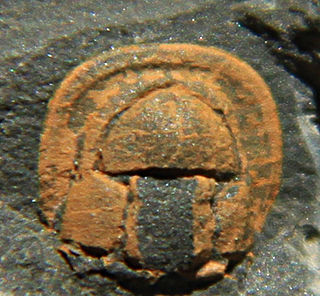
Olenellina is a suborder of the order Redlichiida of Trilobites that occurs about halfway during the Lower Cambrian, at the start of the stage called the Atdabanian. The earliest trilobites in the fossil record are arguably Olenellina, although the earliest Redlichiina and Eodiscina follow quickly. The suborder died out when the Lower passed into the Middle Cambrian, at the end of the stage called Toyonian. A feature uniting the Olenellina is the lack of rupture lines in the headshield, which in other trilobites assist the periodic moulting, associated with arthropod growth. Some derived trilobites have lost facial sutures again, but all of these are blind, while all Olenellina have eyes.
The Kaili Formation is a stratigraphic formation which was deposited during the Lower and Middle Cambrian. The formation is approximately 200 metres (660 ft) thick and was named after the city Kaili in the Guizhou province of southwest China.

Naraoia is a genus of small to average size marine arthropods within the family Naraoiidae, that lived from the early Cambrian to the late Silurian period. The species are characterized by a large alimentary system and sideways oriented antennas.
Laudonia is an extinct genus of trilobites that lived during the early part of the Botomian stage, which lasted from approximately 524 to 518.5 million years ago. This faunal stage was part of the Cambrian Period. There are currently two named species assigned to it.

Archaeaspis is an extinct genus of redlichiid trilobites. It lived during the late Atdabanian stage, which lasted from 521 to 515 million years ago during the early part of the Cambrian Period. The first specimens were first found in Siberia, where they were originally thought to have been endemic. Later, though, more specimen were found in the Inyo Mountains in Southern California. An Ediacarian proarticulatan was given the same name, Archaeaspis Ivantsov, 2001. This is however a junior homonym. The name Archaeaspis Repina in Khomentovskii and Repina, 1965, for the trilobite has priority. The new valid name for the proarticulate is Archaeaspinus Ivantsov, 2007.
Callavia is an extinct, monotypic genus of trilobite arthropods. C. broegeri lived during the late Atdabanian stage, which lasted from 530 to 524 million years ago during the early part of the Cambrian Period in what are today Canada and the United States.
Cirquella is an extinct genus from a well-known class of fossil marine arthropods, the trilobites. It lived during the Atdabanian stage, in the former continent Laurentia.

Nevadella is an extinct genus of trilobites, fossil marine arthropods, with species of average size. It lived during the late Atdabanian stage, which lasted from 530 to 524 million years ago during the early part of the Cambrian Period.

Yunnanocephalus is a genus of ptychopariid trilobite. It lived during the late Atdabanian and Botomian stages, in what are currently Antarctica, Australia and China. It was a "moderately common" member of the Chengjiang Fauna. Yunnanocephalus is the only genus currently assigned to the Yunnanocephalidae family.
Lemdadella is an extinct genus of redlichiid trilobites that lived during the late Atdabanian stage, which lasted from 530 to 524 million years ago during the early part of the Cambrian Period.
Fallotaspidella is an extinct genus of redlichiid trilobites. It lived during the late Atdabanian stage, which lasted from 530 to 524 million years ago during the early part of the Cambrian Period.
Trilobites are used as index fossils to subdivide the Cambrian period. Assemblages of trilobites define trilobite zones. The Olenellus-zone has traditionally marked the top of the Lower Cambrian, and is followed by the Eokochaspis zone.

Fallotaspis is a genus of redlichiid trilobite genus found in Early Cambrian-aged strata of the United States and Morocco.

The Biceratopsinae is an extinct subfamily of redlichiid trilobites within the family Biceratopsidae, with species of small to average size. Species belonging to this subfamily lived during the Toyonian stage, 516-513 million years ago, in the former continent of Laurentia, including what are today the South-Western United States and Canada.

The Olenelloidea are a superfamily of trilobites, a group of extinct marine arthropods. They lived during the late Lower Cambrian and species occurred on all paleocontinents.

The ”Fallotaspidoidea” are a superfamily of trilobites, a group of extinct marine arthropods. It lived during the Lower Cambrian (Atdabanian) and species occurred on all paleocontinents except for the Gondwana heartland. A member of this group, Profallotaspis jakutensis, has long been the earliest known trilobite, but recently the redlichiid Lemdadella has been claimed as occurring even earlier.

Daguinaspis is an early Cambrian trilobite genus found in Morocco. Like the closely related Choubertella and Wolynaspis, but unlike any other Fallotaspidoidea, it lacks genal spines.
Repinaella is an extinct genus from a well-known class of fossil marine arthropods, the trilobites. It lived during the late Atdabanian stage.

Condylopyge is a genus of very small trilobites, that lived during the latest Early and the early Middle Cambrian, in what are today Canada, Czech Republic, England and Wales, France, Germany, Italy, Morocco, the Russian Federation, Spain, Turkey and Sweden. It can easily be distinguished from all other Agnostida because the frontal lobe of the central raised area of the headshield is wider than the rear lobe. It looks like Pleuroctenium but the frontal glabellar lobe does not fold around the rear lobe, as it does in Pleuroctenium.











